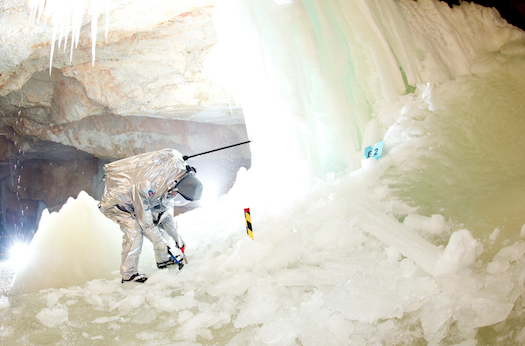

In the ongoing hunt for Martian life, there’s one place astronauts haven’t yet explored deeply: caves. But to delve into Martian caves calls for some heavy-duty gear, and where do you test Martian caving gear on Earth? The Austrian Alps.
See our gallery of the most space-like environments on Earth.
A team of volunteers spent five days at the end of April test-driving spacesuits and planetary rovers inside the ice caves of the awesomely/terrifyingly named Eisriesenwelt — German for “World of the Ice Giants.” On Mars, explorers might run up against limestone caves or ice caverns, and Eisriesenwelt, a series of labyrinthian caves in central Austria cold enough to freeze all water inside, has both. The Martian incarnations are cold but temperatures are stable, there’s less humidity than on the surface of the Red Planet, and they provide shelter against radiation from space — the ideal recipe for sustaining life.
Researchers from the Austrian Space Forum, NASA’s Jet Propulsion Laboratory, and 11 other countries on three continents ran a series of tests 4,265 feet above sea level to see just how well the equipment could hold up under strenuous conditions.
For a spacesuit, volunteers donned the 100-pound Aouda.X suit, which insulates the wearer with an aluminum-coated Kevlar-Panox textile. The Aouda.X is packed with enough monitors — for body temperature, heart rate, and carbon dioxide and oxygen levels — to make sure the person inside is always out of harm’s way. Researchers also stayed in touch over a radio, directing volunteers toward potential ice and other samples.
Some of the many rovers sent along for testing included a cliff reconnaissance vehicle and a quadrotor drone. At least one lesson was learned: a cliff-climbing bot and a more standard surface-dwelling bot make a good team, and might have some potential as a combined machine one day.
There was a slip-up during testing when one volunteer’s headset fell off; researchers opened up the helmet to repair it, which isn’t exactly what you want to do while on Mars. That and a few other things offered some lessons. Gernot Grömer, president of the Austrian Space Forum, told Astrobiology Magazine “yes, we can do subsurface exploration, but we need to adjust our way of conducting Mars exploration significantly.” When the real deal happens, it’ll take astronauts 20 minutes to get a message across to home, and there won’t be anyone except other explorers there to help.
The researchers’ next test run will be in the northern Sahara in Morocco in February 2013.





